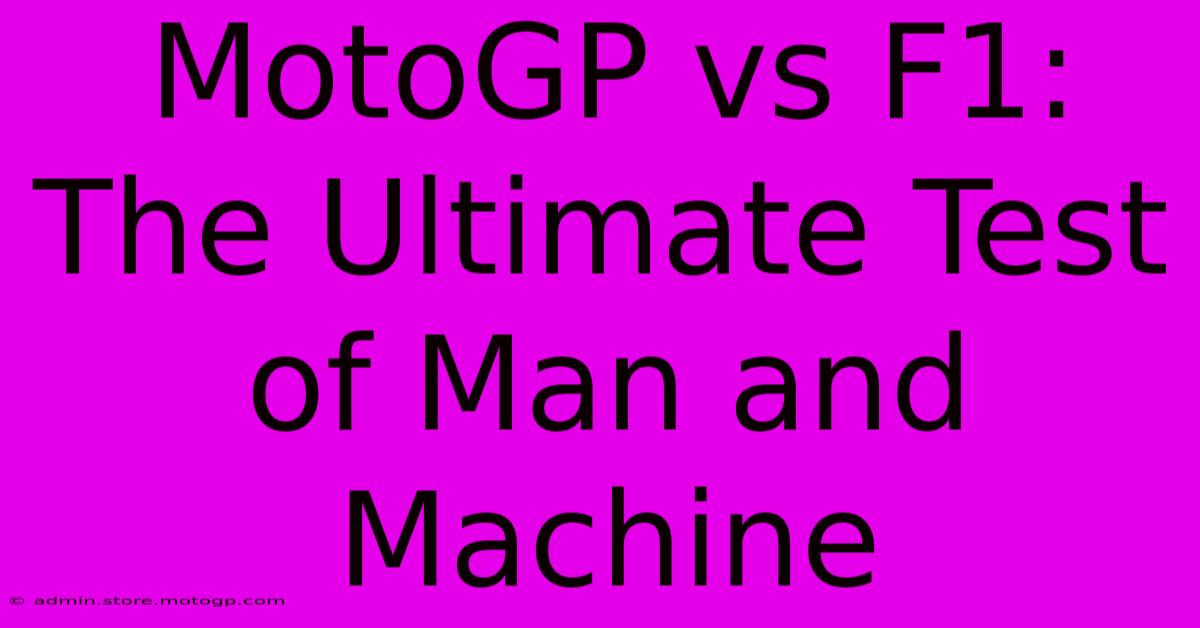MotoGP Vs F1: The Ultimate Test Of Man And Machine

Table of Contents
MotoGP vs F1: The Ultimate Test of Man and Machine
For motorsports enthusiasts, the question often arises: which is the ultimate test of skill – Formula 1 or MotoGP? Both feature incredible speeds, cutting-edge technology, and the very best drivers in the world. But the differences between these two pinnacle motorsport disciplines are significant, leading to distinctly different challenges for the drivers and teams involved. This article dives deep into the heart of this debate, comparing and contrasting MotoGP and F1 to help you determine which truly represents the ultimate test of man and machine.
The Machines: A Tale of Two Approaches
The most immediate difference lies in the machines themselves. F1 cars are sophisticated single-seaters, powered by highly complex 1.6-liter V6 turbo hybrid engines. They are ground effect cars, generating immense downforce for high-speed cornering. The focus is on aerodynamic efficiency and maximizing grip through advanced tire technology and sophisticated suspension systems. Think precision, speed, and technological mastery.
MotoGP bikes, on the other hand, are significantly different beasts. These powerful, lean, prototypes utilize larger displacement engines (up to 1000cc), delivering raw power and requiring exceptional rider skill to control. They rely on rider input to manage traction, braking, and lean angles, with significantly less technological assistance for stability. Think raw power, balance, and intuitive control.
Key Mechanical Differences:
- Engine Type: F1 uses hybrid V6, MotoGP uses large displacement inline four-cylinder or V4 engines.
- Downforce: F1 heavily relies on aerodynamic downforce, MotoGP primarily uses rider skill and lean angle.
- Tire Technology: F1 utilizes sophisticated tire technology optimized for grip and downforce, MotoGP uses specialized slicks that need careful management.
- Weight: F1 cars are significantly heavier than MotoGP bikes.
The Human Element: Skill Sets and Challenges
While both require immense skill, the skill sets needed in F1 and MotoGP differ drastically.
F1 drivers need exceptional car control, race strategy awareness, and the ability to manage tire wear and fuel consumption over long races. They're reliant on precise inputs and the car's technology to achieve optimal performance. Think of precision, strategy, and consistency as key traits.
MotoGP riders demand unparalleled bike control, balance, and reflexes. They need to manage immense power and lean angles while maintaining incredible precision, particularly in the high-speed corners and during overtaking maneuvers. This calls for pure skill, bravery, and incredible physical fitness.
Key Driver Skill Differences:
- Physical Demands: MotoGP riders experience far higher g-forces and physical demands.
- Reaction Time: Both require lightning-fast reactions, but MotoGP demands more instinctive and immediate responses.
- Race Strategy: F1 involves significantly more complex pit strategies and tire management.
The Ultimate Verdict: A Matter of Perspective
Determining which is the ultimate test is subjective. F1 emphasizes technology, strategy, and precision, demanding drivers to be masters of car control within a highly complex system. MotoGP prioritizes raw skill, courage, and instinctive reaction, pushing riders to their physical and mental limits with each race.
Both disciplines represent the pinnacle of motorsport, showcasing incredible feats of engineering and human performance. There's no single "winner" in this debate – the "ultimate test" depends on your personal definition of what constitutes the most demanding and rewarding challenge.
SEO Considerations:
This article incorporates relevant keywords throughout the text, naturally integrating terms such as "MotoGP," "F1," "motorcycle racing," "Formula 1," "motorsports," "drivers," "bikes," "cars," "technology," and "skill." The use of subheadings and bullet points improves readability and SEO. Further off-page SEO would involve promoting this article through social media and other relevant online channels. The use of semantic keywords enhances search engine understanding. This approach helps to improve search engine rankings and drive organic traffic to the article.

Thank you for visiting our website wich cover about MotoGP Vs F1: The Ultimate Test Of Man And Machine. We hope the information provided has been useful to you. Feel free to contact us if you have any questions or need further assistance. See you next time and dont miss to bookmark.
Featured Posts
-
Tnt Sports Moto Gp The Ultimate Racing Resource
Feb 21, 2025
-
Risk Vs Reward The Dangers Of Moto Gp And F1
Feb 21, 2025
-
F1 Parking Pass Book Early And Save Big
Feb 21, 2025
-
Last Minute Circuit Of The Americas Parking Your Options
Feb 21, 2025
-
Moto Gp Sprint Races Witness The Thrills
Feb 21, 2025
